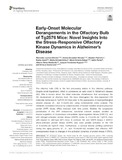Mostrar el registro sencillo del ítem
Early-onset molecular derangements in the olfactory bulb of Tg2576 mice: novel insights into the stress-responsive olfactory kinase dynamics in Alzheimer’s disease
| dc.creator | Lachén Montes, Mercedes | es_ES |
| dc.creator | González Morales, Andrea | es_ES |
| dc.creator | Palomino Alonso, Maialen | es_ES |
| dc.creator | Ausín, Karina | es_ES |
| dc.creator | Gómez-Ochoa, Marta | es_ES |
| dc.creator | Zelaya Huerta, María Victoria | es_ES |
| dc.creator | Ferrer, Isidro | es_ES |
| dc.creator | Pérez Mediavilla, Alberto | es_ES |
| dc.creator | Fernández Irigoyen, Joaquín | es_ES |
| dc.creator | Santamaría, Enrique | es_ES |
| dc.date.accessioned | 2019-06-20T08:02:56Z | |
| dc.date.available | 2019-06-20T08:02:56Z | |
| dc.date.issued | 2019 | |
| dc.identifier.issn | 1663-4365 (Electronic) | |
| dc.identifier.uri | https://hdl.handle.net/2454/33466 | |
| dc.description.abstract | The olfactory bulb (OB) is the first processing station in the olfactory pathway. Despite smell impairment, which is considered an early event in Alzheimer’s disease (AD), little is known about the initial molecular disturbances that accompany the AD development at olfactory level. We have interrogated the time-dependent OB molecular landscape in Tg2576 AD mice prior to the appearance of neuropathological amyloid plaques (2-, and 6-month-old), using combinatorial omics analysis. The metabolic modulation induced by overproduction of human mutated amyloid precursor protein (APP) clearly differs between both time points. Besides the progressive perturbation of the APP interactome, functional network analysis unveiled an inverse regulation of downstream extracellular signal-regulated kinase (ERK1/2), and p38 mitogen-activated protein kinase (MAPK) routes in 2-month-old Tg2576 mice with respect to wild-type (WT) mice. In contrast, Akt and MAPK kinase 4 (SEK1)/ stress-activated protein kinase (SAPK) axis were parallel activated in the OB of 6-months-old-Tg2576 mice. Furthermore, a survival kinome profiling performed during the aging process (2-, 6-, and 18-month-old) revealed that olfactory APP overexpression leads to changes in the activation dynamics of protein kinase A (PKA), and SEK1/MKK4-SAPK/JNK between 6 and 18 months of age, when memory deficits appear and AD pathology is well established in transgenic mice. Interestingly, both olfactory pathways were differentially activated in a stage-dependent manner in human sporadic AD subjects with different neuropathological grading. Taken together, our data reflect the early impact of mutated APP on the OB molecular homeostasis, highlighting the progressive modulation of specific signaling pathways during the olfactory amyloidogenic pathology. | en |
| dc.description.sponsorship | This work was funded by grants from the Spanish Ministry of Economy and Competitiveness (Ministerio de Economía, Industria y Competitividad, Gobierno de España, MINECO; Ref. SAF2014-59340-R), Department of Economic Development from Government of Navarra (Ref. PC023-PC024, PC025, PC081-82, PI59 and PC107-108) and Obra Social la Caixa to ES. AG-M and KA were supported by PEJ-2014-A-61949 and PEJ-2014-A-72151 (MINECO). ML-M and AG-M are supported by a predoctoral fellowship from the Public University of Navarra (UPNA). The Proteomics Unit of Navarrabiomed is a member of Proteored, PRB3-ISCIII, and is supported by grant PT17/0019/009, of the PE I + D + I 2013-2016 funded by ISCIII and FEDER. | en |
| dc.format.extent | 17 p. | |
| dc.format.mimetype | application/pdf | en |
| dc.language.iso | eng | en |
| dc.publisher | Frontiers Media | en |
| dc.relation.ispartof | Frontiers in Aging Neuroscience 11:141 | en |
| dc.rights | © 2019 Lachen-Montes, González-Morales, Palomino, Ausin, Gómez- Ochoa, Zelaya, Ferrer, Pérez-Mediavilla, Fernández-Irigoyen and Santamaría. This is an open-access article distributed under the terms of the Creative Commons Attribution License (CC BY). The use, distribution or reproduction in other forums is permitted, provided the original author(s) and the copyright owner(s) are credited and that the original publication in this journal is cited, in accordance with accepted academic practice. No use, distribution or reproduction is permitted which does not comply with these terms. | en |
| dc.rights.uri | https://creativecommons.org/licenses/by/4.0/ | |
| dc.subject | Alzheimer’s disease | en |
| dc.subject | Olfactory bulb | en |
| dc.subject | Network biology | en |
| dc.subject | Proteomics | en |
| dc.subject | Transcriptomics | en |
| dc.subject | Tg2576 mice | en |
| dc.title | Early-onset molecular derangements in the olfactory bulb of Tg2576 mice: novel insights into the stress-responsive olfactory kinase dynamics in Alzheimer’s disease | en |
| dc.type | info:eu-repo/semantics/article | en |
| dc.type | Artículo / Artikulua | es |
| dc.contributor.department | Ciencias de la Salud | es_ES |
| dc.contributor.department | Osasun Zientziak | eu |
| dc.rights.accessRights | info:eu-repo/semantics/openAccess | en |
| dc.rights.accessRights | Acceso abierto / Sarbide irekia | es |
| dc.identifier.doi | 10.3389/fnagi.2019.00141 | |
| dc.relation.projectID | info:eu-repo/grantAgreement/MINECO//SAF2014-59340-R/ES/ | en |
| dc.relation.publisherversion | https://doi.org/10.3389/fnagi.2019.00141 | |
| dc.type.version | info:eu-repo/semantics/publishedVersion | en |
| dc.type.version | Versión publicada / Argitaratu den bertsioa | es |
| dc.contributor.funder | Gobierno de Navarra / Nafarroako Gobernua | es |
| dc.contributor.funder | Universidad Pública de Navarra / Nafarroako Unibertsitate Publikoa | es |
Ficheros en el ítem
Este ítem aparece en la(s) siguiente(s) colección(ones)
La licencia del ítem se describe como © 2019 Lachen-Montes, González-Morales, Palomino, Ausin, Gómez-
Ochoa, Zelaya, Ferrer, Pérez-Mediavilla, Fernández-Irigoyen and Santamaría. This
is an open-access article distributed under the terms of the Creative Commons
Attribution License (CC BY). The use, distribution or reproduction in other forums
is permitted, provided the original author(s) and the copyright owner(s) are credited
and that the original publication in this journal is cited, in accordance with accepted
academic practice. No use, distribution or reproduction is permitted which does not
comply with these terms.



